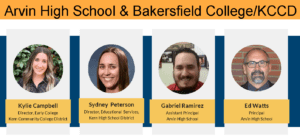Last week’s CLP webinar, Equitable Dual Enrollment: Applying for the New State Grants, featured Arvin High School’s award-winning dual enrollment partnership with Bakersfield College. Presenters from Arvin High School and the Kern High School District, along with the partner Bakersfield College of Kern Community College District, joined CLP to talk about key ingredients that helped their dual enrollment partnership evolve from a small set of courses to their current offerings of 52 sections of college courses that lead to certificates, degrees and transfer. Arvin is a rural high school serving mostly low-income Latinx students. When Bakersfield College began to expand dual enrollment they focused first on serving students in rural areas like Arvin where college degree attainment rates are low as a deliberate equity strategy.
College began to expand dual enrollment they focused first on serving students in rural areas like Arvin where college degree attainment rates are low as a deliberate equity strategy.
The webinar also provided an overview of the new dual enrollment grant RFAs with a focus on the College and Career Access Pathways (CCAP) RFA. And participants got to hear an update on allowable grant expenses from the California Department of Education (CDE). The Q&A session at the end of the webinar addressed participants’ specific questions and included ideas for using grant funds. Access the webinar recording and slides.
Highlights from the webinar:
-
- Effective partnership between the high school and college is the bedrock of dual enrollment. It takes time and effort to build that partnership. According to Arvin High School Principal Ed Watts, “The key magic ingredient—the magic sauce—in all of this is partnership.” Dual enrollment entails navigating the intersection of two complex systems, K-12 and community college, and he noted, “the systems are diametrically different in a lot of aspects.… When you first get in this partnership, the conversations have to be very close.… The vision has to be clear.”
- For those just getting started with dual enrollment, it’s okay to start small–but be strategic. Arvin High School started small with CTE pathways, and over eight years, they built up their dual enrollment offerings to the current 52 sections. Sydney Peterson, Director of Educational Services at Kern High School District, emphasized the importance of strategic conversations so that partners are figuring out what students need, what the labor market needs, and how the high school and college can bring their collective resources together to design the approach to dual enrollment. She said, “It’s not about entering into some of these grants, or working with the funding that you have and just throwing everything at the wall and hoping it sticks. It really does need to be strategic.”
- Diane Crum, Education Programs Consultant in the High School Innovations and Initiatives Office of the CDE, provided clarification on a few questions about allowable expenses that came up at the February 23 CDE informational webinar on the dual enrollment grant RFAs.
- Be sure to consider sustainability when budgeting for personnel expenses. Funds can go toward salary and benefits, including new hires, but it’s important to note that the maximum grant is $100,000 over a four-year period. That’s not a lot to support a new hire, particularly because program sustainability needs to be addressed in the grant application.
- Allowable expenses support the primary goals of the dual enrollment grant. Use the budget justification to explain this and provide background context for the expenses. As an example, Diane referenced a question that came up in the CDE webinar. An audience member had asked about transportation, and whether grant funds could be used to purchase a van. Without further justification about how the van purchase would help fulfill the purpose of the grant, it might not be considered an allowable expense. But she went on to note, “if you believe that it’s going to expand the number of students in your [dual enrollment] program, and you can justify it,” then it might be allowable.
- The dual enrollment grants can provide resources to design and implement high quality dual enrollment for students who wouldn’t otherwise go to college or who are underserved in higher education, the intent of CCAP legislation. They also provide opportunity to build CCAP dual enrollment in anticipation of the forthcoming funding for the Golden State Pathways, which requires at least 12 units of early college credit for each pathway.
Other resources
-
- RFA links and contact emails.
- CCAP RFA
- Middle College Early College (MCEC) RFA
- Questions for CCAP RFA: CCAPgrant@cde.ca.gov
- Questions for MCEC RFA: MCECgrant@cde.ca.gov
- Bring your dual enrollment high school-college partnership team to the California Dual Enrollment Equity conference on May 2-3 in Bakersfield. The conference includes site visits to see work in action. The conference is presented by CLP, Kern Community College District, and the Education Trust–West. Register today.
- CCEMC webinar recording and Q&A
- Learning-Aligned Employment Program (LAEP) from the California Student Aid Commission. LAEP offers eligible students at public colleges and universities the opportunity to earn money to help defray their educational costs while gaining education-aligned, career-related employment. Partnerships may recruit LAEP eligible students as tutor or near-peer mentors for dual enrollment.
- Dual enrollment agreement templates and other information from Kern Community College District.
- To join CLP’s virtual dual enrollment community of practice, click here.
- RFA links and contact emails.
Webinar presenters
Ed Watts, Principal, Arvin High School
Gabriel Ramirez, Assistant Principal, Arvin High School
Sydney Peterson, Director, Educational Services, Kern High School District
Kylie Campbell, Director, Early College, Kern Community College District
Laurencia Walker, Director, Career Ladders Project
Naomi Castro, Senior Director, Career Ladders Project
With special appearance by: Diane Crum, Education Programs Consultant, High School Innovations and Initiatives Office, California Department of Education